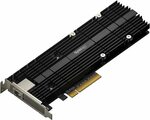M.2 SSD & 10GbE combo adapter card for performance acceleration
Achieve Multi-Gig Ethernet transmission speeds of up to 10 Gbps
Accelerate random I/O performance with the dual M.2 2280/22110 NVMe SSD slots
Dedicated cache slots, free up primary drive bays for data storage
More info:
https://www.synology.com/en-au/products/E10M20-T1
10GbE bandwidth and M.2 SSD cache, all at once
Synology E10M20-T1 helps you boost I/O performance and network bandwidth simultaneously using just one PCIe expansion slot on your Synology NAS.Compatible models: (From Synology Website) https://www.synology.com/en-au/products/E10M20-T1
SA series:SA3600, SA3400
20 series:RS820RP+, RS820+
19 series:DS2419+, DS1819+
18 series:RS2818RP+, DS3018xs, DS1618+
Next cheapest price in Australia $449.00
Edit:
Typical Use Scenario
2x M2 Cards for Data Caching (1x Read, 1x Write)
1x 10gbE Ethernet Port (RJ45)
This allows you to get read/write cache + 10gbe ethernet without sacrificing a hotswap bays on models with only 1x PCI Express Expansion Slot.
Prior to this on Supported Synology Devices you only had one expansion slot, and hence forced to decide between an M2 drive or 10gbe ethernet.



 CamelCamelCamel
CamelCamelCamel

Is this expansion card for Synology devices? Which series is it compatible with?